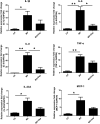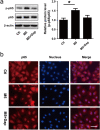Daphnetin inhibits proliferation and inflammatory response in human HaCaT keratinocytes and ameliorates imiquimod-induced psoriasis-like skin lesion in mice
- PMID: 33081840
- PMCID: PMC7576854
- DOI: 10.1186/s40659-020-00316-0
Daphnetin inhibits proliferation and inflammatory response in human HaCaT keratinocytes and ameliorates imiquimod-induced psoriasis-like skin lesion in mice
Abstract
Background: Psoriasis is a common chronic inflammatory skin disease. Keratinocytes hyperproliferation and excessive inflammatory response contribute to psoriasis pathogenesis. The agents able to attenuate keratinocytes hyperproliferation and excessive inflammatory response are considered to be potentially useful for psoriasis treatment. Daphnetin exhibits broad bioactivities including anti-proliferation and anti-inflammatory. This study aims to evaluate the anti-psoriatic potential of daphnetin in vitro and in vivo, and explore underlying mechanisms.
Methods: HaCaT keratinocytes was stimulated with the mixture of IL-17A, IL-22, oncostatin M, IL-1α, and TNF-α (M5) to establish psoriatic keratinocyte model in vitro. Cell viability was measured using Cell Counting Kit-8 (CCK-8). Quantitative Real-Time PCR (qRT-PCR) was performed to measure the mRNA levels of hyperproliferative marker gene keratin 6 (KRT6), differentiation marker gene keratin 1 (KRT1) and inflammatory factors IL-1β, IL-6, IL-8, TNF-α, IL-23A and MCP-1. Western blotting was used to detect the protein levels of p65 and p-p65. Indirect immunofluorescence assay (IFA) was carried out to detect p65 nuclear translocation. Imiquimod (IMQ) was used to construct psoriasis-like mouse model. Psoriasis severity (erythema, scaling) was scored based on Psoriasis Area Severity Index (PASI). Hematoxylin and eosin (H&E) staining was performed to examine histological change in skin lesion. The expression of inflammatory factors including IL-6, TNF-α, IL-23A and IL-17A in skin lesion was measured by qRT-PCR.
Results: Daphnetin attenuated M5-induced hyperproliferation in HaCaT keratinocytes. M5 stimulation significantly upregulated mRNA levels of IL-1β, IL-6, IL-8, TNF-α, IL-23A and MCP-1. However, daphnetin treatment partially attenuated the upregulation of those inflammatory cytokines. Daphnetin was found to be able to inhibit p65 phosphorylation and nuclear translocation in HaCaT keratinocytes. In addition, daphnetin significantly ameliorate the severity of skin lesion (erythema, scaling and epidermal thickness, inflammatory cell infiltration) in IMQ-induced psoriasis-like mouse model. Daphnetin treatment attenuated IMQ-induced upregulation of inflammatory cytokines including IL-6, IL-23A and IL-17A in skin lesion of mice.
Conclusions: Daphnetin was able to attenuate proliferation and inflammatory response induced by M5 in HaCaT keratinocytes through suppression of NF-κB signaling pathway. Daphnetin could ameliorate the severity of skin lesion and improve inflammation status in IMQ-induced psoriasis-like mouse model. Daphnetin could be an attractive candidate for future development as an anti-psoriatic agent.
Keywords: Daphnetin; Inflammatory response; NF-κb signaling pathway; Proliferation; Psoriasis.
Conflict of interest statement
The authors declare no competing interests.
Figures








Similar articles
-
Astragaloside IV suppresses the proliferation and inflammatory response of human epidermal keratinocytes and ameliorates imiquimod-induced psoriasis-like skin damage in mice.Allergol Immunopathol (Madr). 2024 Sep 1;52(5):44-50. doi: 10.15586/aei.v52i5.1140. eCollection 2024. Allergol Immunopathol (Madr). 2024. PMID: 39278850
-
18β-Glycyrrhetinic acid induces human HaCaT keratinocytes apoptosis through ROS-mediated PI3K-Akt signaling pathway and ameliorates IMQ-induced psoriasis-like skin lesions in mice.BMC Pharmacol Toxicol. 2020 Jun 3;21(1):41. doi: 10.1186/s40360-020-00419-0. BMC Pharmacol Toxicol. 2020. PMID: 32493482 Free PMC article.
-
Gentiopicroside-Loaded Chitosan Nanoparticles Inhibit TNF-α-Induced Proliferation and Inflammatory Response in HaCaT Keratinocytes and Ameliorate Imiquimod-Induced Dermatitis Lesions in Mice.Int J Nanomedicine. 2023 Jul 10;18:3781-3800. doi: 10.2147/IJN.S406649. eCollection 2023. Int J Nanomedicine. 2023. PMID: 37457802 Free PMC article.
-
Understanding psoriatic disease at single-cell resolution: an update.Curr Opin Rheumatol. 2025 Jul 1;37(4):254-260. doi: 10.1097/BOR.0000000000001085. Epub 2025 Mar 29. Curr Opin Rheumatol. 2025. PMID: 40160177 Review.
-
Updated Perspectives on Keratinocytes and Psoriasis: Keratinocytes are More Than Innocent Bystanders.Psoriasis (Auckl). 2022 May 2;12:73-87. doi: 10.2147/PTT.S327310. eCollection 2022. Psoriasis (Auckl). 2022. PMID: 35529056 Free PMC article. Review.
Cited by
-
Elevated SIRT3 Parkin-dependently activates cell mitophagy to ameliorate TNF-α-induced psoriasis-related phenotypes in HaCaT cells through deacetylating FOXO3a for its activation.Arch Dermatol Res. 2023 May;315(4):847-857. doi: 10.1007/s00403-022-02453-w. Epub 2022 Nov 9. Arch Dermatol Res. 2023. PMID: 36352150
-
Discovery of a Novel Inhibitor Structure of Mycobacterium tuberculosis Isocitrate Lyase.Molecules. 2022 Apr 11;27(8):2447. doi: 10.3390/molecules27082447. Molecules. 2022. PMID: 35458645 Free PMC article.
-
TNFSF14-HVEM/LTβR Exacerbates Keratinocyte Abnormalities and IMQ-Induced Psoriatic Skin Inflammation via Activating NF-κB/TWIST1 Signalling Pathway.J Cell Mol Med. 2025 Aug;29(15):e70774. doi: 10.1111/jcmm.70774. J Cell Mol Med. 2025. PMID: 40768619 Free PMC article.
-
Mechanistic interplay of various mediators involved in mediating the neuroprotective effect of daphnetin.Pharmacol Rep. 2021 Oct;73(5):1220-1229. doi: 10.1007/s43440-021-00261-z. Epub 2021 Apr 16. Pharmacol Rep. 2021. PMID: 33860917 Review.
-
Revolutionizing Psoriasis Topical Treatment: Enhanced Efficacy Through Ceramide/Phospholipid Composite Cerosomes Co-Delivery of Cyclosporine and Dithranol: In-Vitro, Ex-Vivo, and in-Vivo Studies.Int J Nanomedicine. 2024 Feb 7;19:1163-1187. doi: 10.2147/IJN.S443812. eCollection 2024. Int J Nanomedicine. 2024. PMID: 38344440 Free PMC article.
References
MeSH terms
Substances
Grants and funding
LinkOut - more resources
Full Text Sources
Medical
Miscellaneous

